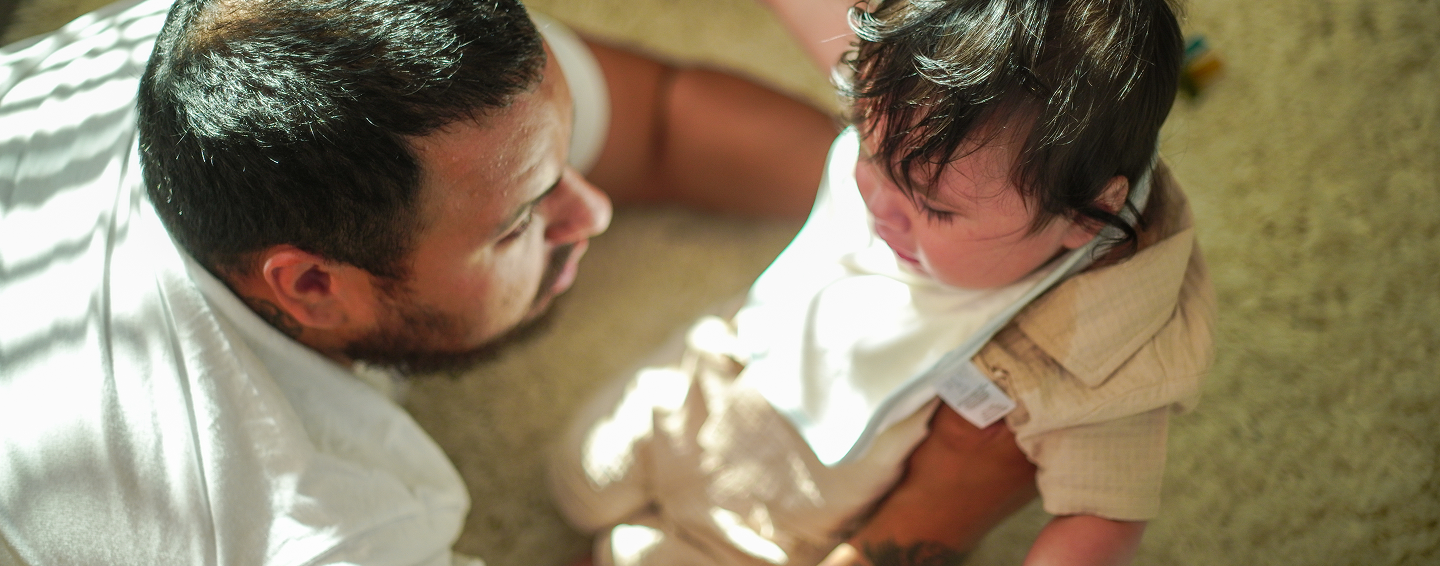Why White Noise in the Womb Is Your Baby's Natural Sleep Aid
White noise in the womb is the constant background sound your baby hears for nine months before birth - a mix of your heartbeat, blood flow, breathing, and digestive sounds that reaches up to 91 decibels. Here's what every parent should know:
- Sound levels: Womb noise is as loud as a vacuum cleaner (70-91 dB)
- When it starts: Babies can hear by 18-20 weeks of pregnancy
- What they hear: Bowel sounds, heartbeat, and blood flow create natural white noise
- After birth: 80% of newborns fall asleep within 5 minutes when exposed to white noise
- Safety guideline: Keep postnatal white noise at 50 dB maximum, placed away from baby
For nine months, your baby lived in a surprisingly noisy world. The womb isn't quiet - it's filled with the constant whooshing of amniotic fluid, the rhythm of your heartbeat, and what researchers describe as "loud transient pops" from bowel sounds occurring five times per second.
Then suddenly, they're born into what feels like shocking silence.
This dramatic change from a 75-91 decibel environment to a quiet nursery can actually stress newborns. Research from 1990 found that white noise helped 80% of babies fall asleep within five minutes, compared to just 25% without it.
I'm Gary Harutyunyan, and my journey with white noise in the womb began when my newborn struggled with sleep despite trying every solution available. This challenge led me to create the Sleepy Baby device, combining gentle rhythmic patting with womb-mimicking sounds to help families finally get the rest they need.
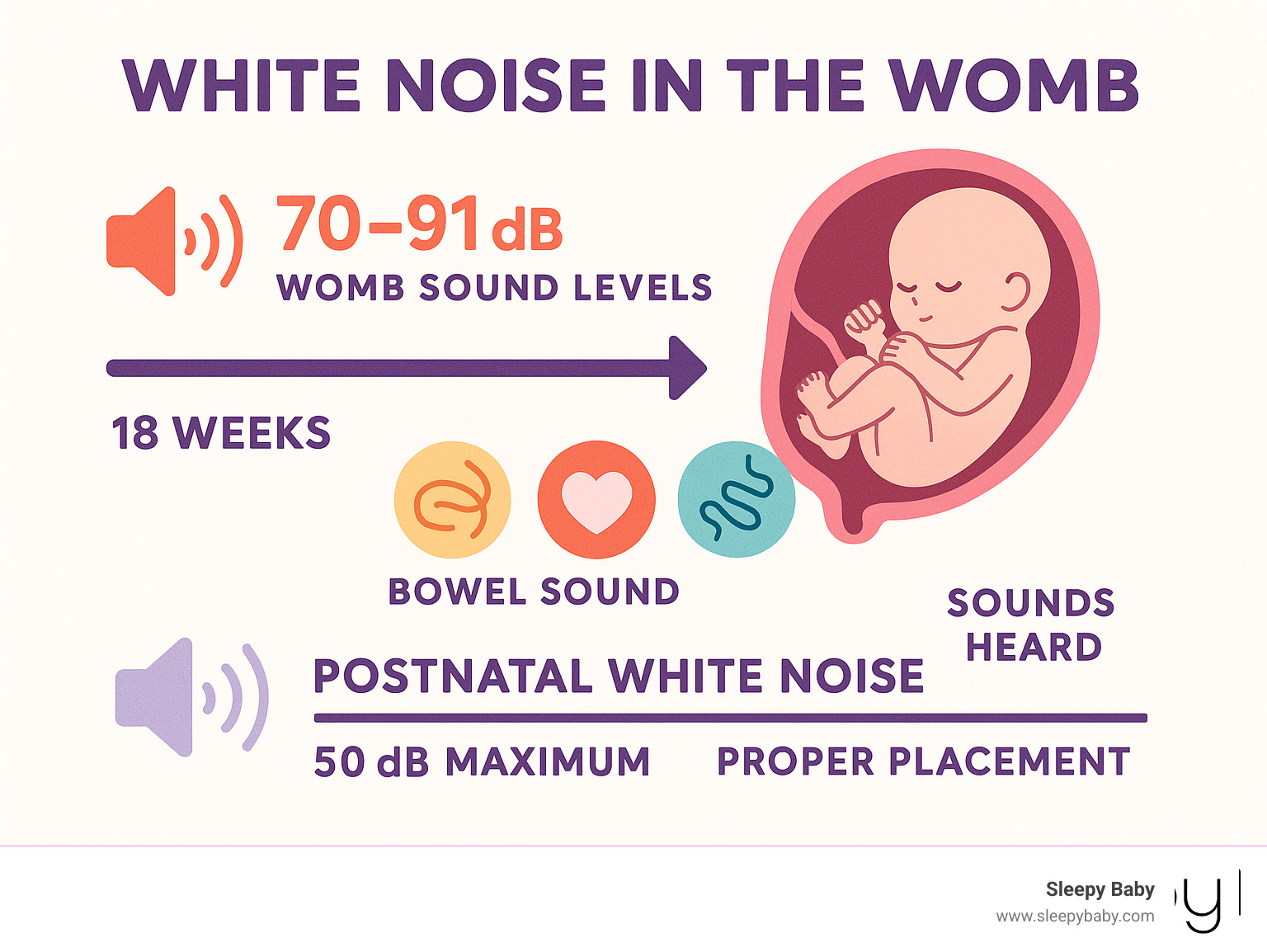
The Science of White Noise in the Womb
The womb isn't the peaceful, quiet sanctuary most people imagine. For nine months, your baby lives in what scientists describe as a surprisingly busy acoustic world - and understanding this environment changes everything about how we think about newborn sleep.
White noise in the womb comes from an amazing mix of sounds your body creates naturally. Your heartbeat provides a steady rhythm, but it's actually the whooshing of blood flow and those surprising "pop" sounds from your digestive system that dominate your baby's acoustic world.
The amniotic fluid acts like a built-in speaker system, filtering and amplifying sounds in fascinating ways. Lower frequencies travel through beautifully, while higher-pitched sounds get muffled. This creates that signature deep, rumbling environment that becomes your baby's comfort zone.
What really amazed researchers was finding that bowel sounds - not your heartbeat - are actually the loudest and most frequent sounds your baby hears. These little "pops" happen about five times every second, creating a constant backdrop that's far from quiet.
Recent studies using tiny microphones have measured womb noise levels at an impressive 70-90 decibels. Some recordings even hit 91 dB. To put that in perspective, that's as loud as a vacuum cleaner running constantly. You can learn more about fetal hearing development from recent research.
When Does Baby Start Listening?
Your baby's hearing journey begins around 18-20 weeks of pregnancy, when your baby's ears develop enough to actually process sounds.
By the second trimester, your little one isn't just hearing sounds - they're actively listening and learning. Around 25 weeks, you might notice your baby startling when there's a sudden loud noise nearby. That little jump is proof that their auditory system is working beautifully.
This means for the final 15-20 weeks of pregnancy, your baby is getting a masterclass in sound, becoming completely comfortable with that constant white noise in the womb.
Why "White Noise in the Womb" Sounds So Loud
That 91-decibel measurement often shocks parents who've been whispering around their sleeping babies. But your baby spent months in an environment louder than your dishwasher, and they found it completely soothing.
Low-frequency sounds travel through your body much better than high-pitched sounds. It's like your baby is living inside a natural bass speaker, where the deep whooshes and rhythmic sounds come through crystal clear.
Your amniotic fluid acts as both a conductor and a filter. As your pregnancy progresses, higher frequencies get filtered out more, while the low-frequency sounds (between 10-100 Hz) stay strong and consistent. This is why vacuum cleaner sounds often calm fussy babies - they're remarkably similar to what felt normal in the womb.
What Exactly Is White Noise?
White noise contains all the different frequencies your ears can hear, played at equal intensity. This creates what scientists call a masking effect - it throws a blanket over other sounds, making sudden noises less likely to startle your baby awake.
The white noise in the womb isn't technically perfect white noise, but it works the same way. All those combined sounds create a consistent acoustic environment that masks sudden changes and provides comfort.

How Womb Sounds Shape Fetal Brain and Sleep
The constant acoustic environment of the womb does more than just provide background noise - it actively shapes your baby's developing brain and establishes the foundation for healthy sleep patterns.
During fetal development, the brain undergoes massive neural pruning, where unused connections are eliminated while frequently used pathways are strengthened. The consistent white noise in the womb helps establish neural pathways related to sleep regulation and auditory processing. Your baby's brain learns to associate these sounds with safety, comfort, and rest.
Fetuses spend approximately 95% of their time sleeping, developing their circadian rhythms while surrounded by the constant hum of maternal sounds. This early exposure to rhythmic, predictable noise patterns helps establish the neurological foundations for healthy sleep cycles after birth.
External Voices, Music & Myths
One of the most persistent myths about prenatal development is that playing classical music - particularly Mozart - to your unborn baby will boost their intelligence. Scientific research on fetal hearing has thoroughly debunked this "Mozart effect" for prenatal development.
While fetuses can hear external sounds, the amniotic fluid and maternal tissues significantly filter what reaches them. High-frequency sounds are attenuated, meaning complex musical arrangements lose much of their detail.
If you want to play music during pregnancy, choose simple, consonant melodies with minimal complexity. Most importantly, if the music relaxes you, it's likely beneficial for your baby too, since maternal stress directly affects fetal development.
"White Noise in the Womb" vs Modern Machines
A 1993 study exposed fetuses at 36-41 weeks gestation to white noise at 100 dB for 5 minutes and found it did not induce fetal sleep. This suggests that while white noise in the womb is constant and familiar, it doesn't necessarily make babies sleepy while they're still in utero.
The magic happens after birth, when the contrast between the noisy womb and the quiet outside world becomes apparent. The absence of familiar sounds can actually be stressful for newborns.
Modern white noise machines attempt to replicate this environment, but many fall short. Commercial "womb sounds" often lack the irregular, low-frequency bowel-sound pops that dominate real womb recordings. The most effective devices focus on continuous, monotonous, low-pitch sounds like those produced by hair dryers or vacuum cleaners.
From Bump to Bassinet: Evidence After Birth
The landmark 1990 study published in Archives of Disease in Childhood provides compelling evidence for how white noise in the womb translates to postnatal soothing benefits.
In this randomized controlled trial, researchers exposed newborns aged 2-7 days to white noise designed to replicate intrauterine sounds. The results were remarkable: 80% of babies fell asleep within five minutes when exposed to white noise, compared to only 25% in the control group.
This dramatic difference suggests that white noise actively triggers the "calming reflex" by recreating the familiar acoustic environment of the womb. The babies weren't just tolerating the noise; they were finding genuine comfort in it.
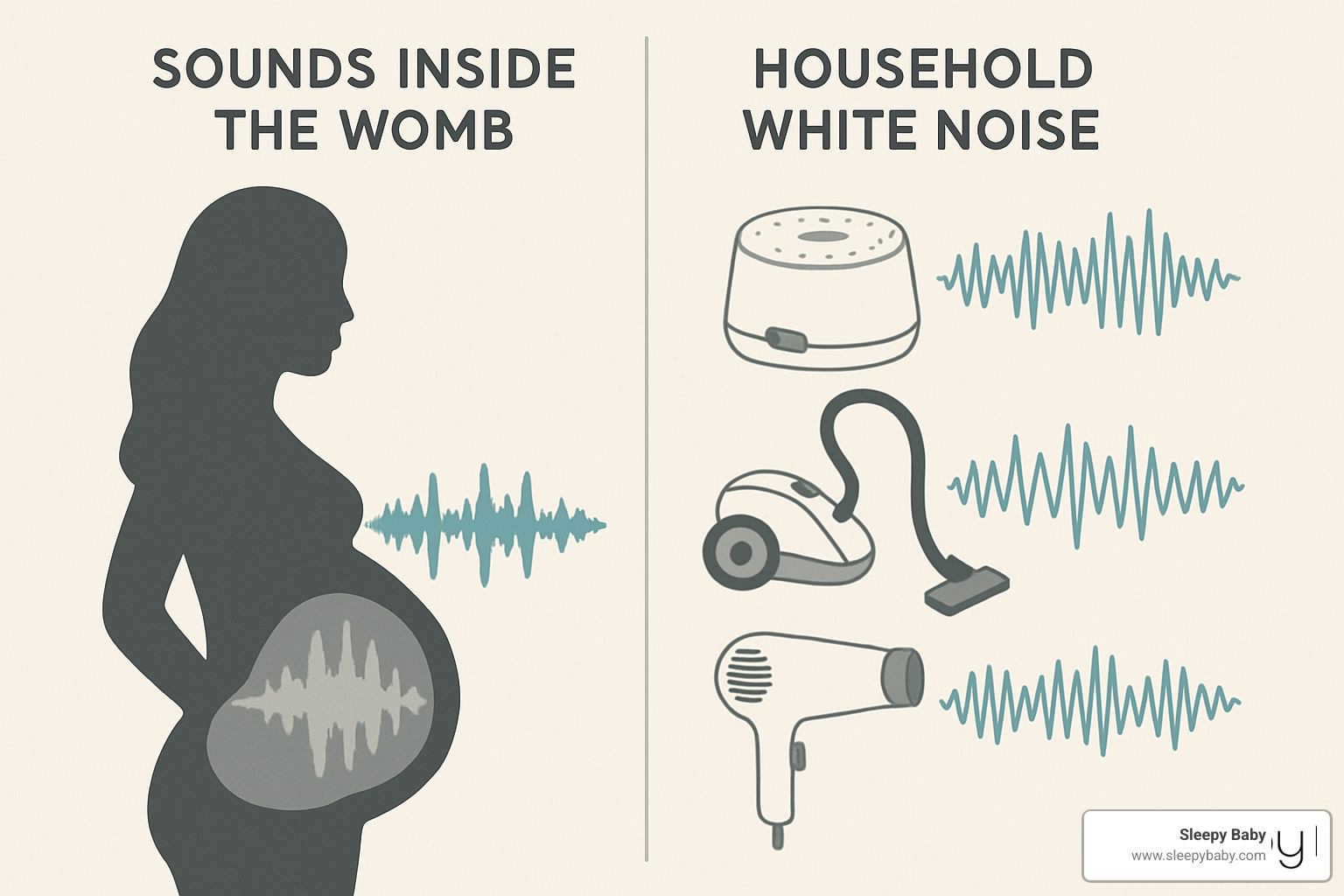
Bringing the Womb Home: Using White Noise Safely After Birth
Understanding the science behind white noise in the womb is just the beginning. The real challenge comes when you bring your baby home and try to recreate that familiar acoustic environment safely.
Your baby just spent nine months in an environment louder than a vacuum cleaner. Now they're suddenly in a quiet nursery, and that silence can actually feel stressful. White noise helps bridge this gap by soothing newborns with familiar sounds while blocking sudden sounds like door slams that might startle them awake.
But here's the crucial difference: your baby no longer has amniotic fluid protecting their ears. That's why the AAP 50 dB rule exists - white noise should never exceed 50 decibels after birth, about the volume of a quiet dishwasher. The safe distance rule is equally important - white noise machines should sit at least seven feet away from your baby's crib.
One worry that keeps many parents up at night is creating dependency concerns. The truth is, some babies do develop preferences for consistent background sound - just like adults who sleep better with a fan running. This isn't necessarily problematic if managed thoughtfully.
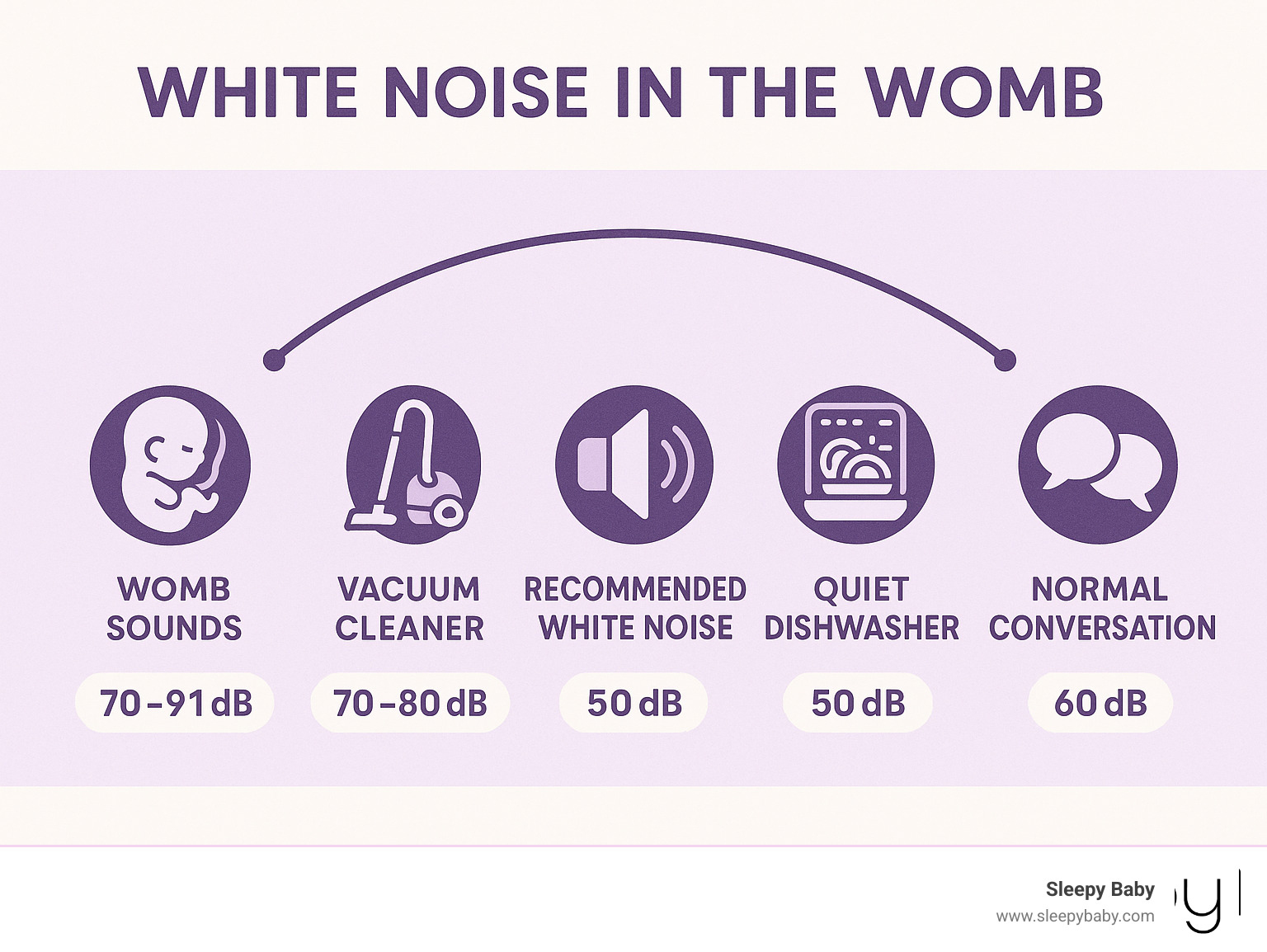
White Noise in the Womb vs Pink & Brown Noise
Not all noise colors work the same way for babies. Understanding the differences between white, pink, and brown noise can help you choose what works best.
White noise contains all frequencies at equal intensity - that familiar static sound. It's the closest match to the broadband nature of womb sounds, making it ideal for newborns.
Pink noise reduces higher frequencies, creating a deeper, more mellow sound. Think of gentle rain. Research shows adult deep-sleep data improves with pink noise, and some babies find it more soothing than traditional white noise.
Brown noise emphasizes very low frequencies, creating an even deeper rumbling sound. The frequency curves show it's gentler on developing ears since we're naturally less sensitive to low frequencies.
For newborns making that dramatic transition from womb to world, white noise often works best. But as babies reach four to six months, many parents notice their little ones respond better to pink or brown noise.
Safety Checklist & Common Mistakes
Creating a safe white noise environment requires attention to several key factors.
Speaker placement is crucial - keep devices at least seven feet from your baby's sleeping area. Never attach speakers to the crib.
Measure with phone app technology to ensure you're staying within safe limits. The free NIOSH SLM app gives you accurate decibel readings. If you need to raise your voice to talk over the white noise, it's definitely too loud.
Avoid 24/7 playback - your baby needs to learn the difference between sleep time and awake time. Use white noise primarily during naps and nighttime sleep.
Room acoustics matter more than most parents realize. Hard surfaces can amplify sound, while carpets and soft furnishings absorb it. You might need to adjust volume based on your nursery setup.
Busting Common Myths
Several persistent myths about white noise create unnecessary worry for parents.
The hearing damage fear tops the list, but when used at appropriate volumes and distances, white noise is safe. The womb was much louder than the 50-decibel recommendation for postnatal use.
The speech-delay myth has no scientific backing. Babies need exposure to varied sounds and conversations during wake times, but consistent background noise during sleep doesn't interfere with language development.
Some parents worry about sudden-silence shock - that their baby will be traumatized if the white noise stops unexpectedly. While abrupt changes can be startling, babies are remarkably adaptable. The goal is creating predictable, comfortable sleep environments, not maintaining absolute acoustic consistency every moment.
Practical Tips & Parent-Friendly Tools
Moving from understanding white noise in the womb to actually using it at home doesn't have to be overwhelming. With a few simple tools and the right approach, you can create that familiar womb-like environment your baby craves.
Your smartphone can become your best friend here - download the free NIOSH SLM app to measure sound levels in your baby's room. This takes all the guesswork out of volume control.
For creating white noise, you have more options than you might think. Dedicated white noise machines work great, but that box fan in your closet or air purifier can do the job beautifully. Some parents swear by household sound recordings - the dishwasher running, a vacuum cleaner, or even a hair dryer. These deeper, more mechanical sounds often mirror the white noise in the womb better than digital generators.
Portability is key for maintaining routines. Battery-powered devices or smartphone apps ensure your baby's familiar sounds travel with you. This consistency becomes especially important as you help your little one develop self-soothing skills alongside their white noise comfort.
Step-by-Step Bedtime Routine
The magic isn't just in the white noise itself - it's in how you weave it into a predictable bedtime sequence.
Start with a warm bath to naturally relax your baby's muscles and signal that bedtime is approaching. Follow with feeding time, whether you're breastfeeding or bottle-feeding. A satisfied baby is much more likely to settle peacefully.
Swaddling or a sleep sack comes next, recreating that snug, secure feeling your baby knew in the womb. Keep safe sleep guidelines in mind - nothing loose in the crib.
Here's where timing matters: start your white noise before placing your baby in the crib. You want them to associate the sound with their sleep space, not with your response to crying.
Dim the lights slowly rather than plunging the room into sudden darkness. Think sunset, not light switch.
The secret sauce is consistency. Following the same sequence every night helps your baby's brain prepare for sleep before you even reach the crib.
Monitoring Volume & Distance
Getting the volume and placement right is where many well-meaning parents go wrong. That 50-decibel guideline means your white noise should sound like a quiet dishwasher or gentle rainfall.
Use your NIOSH SLM app to measure sound levels right where your baby sleeps, not where the machine sits. Sound travels and disperses, so a device reading 60 dB at arm's length might only produce 45 dB at your baby's crib when properly positioned.
Your room's setup makes a huge difference. Hard floors and bare walls bounce sound around, while carpets and curtains soak it up. You might need to adjust volume based on whether you're dealing with an echo chamber or a sound-absorbing cocoon.
Distance is your friend - keep that white noise machine at least 7 feet from your baby's sleeping area. This creates ambient sound rather than directional noise.
When & How to Wean Off White Noise
Most babies start showing readiness around 4-6 months as they develop stronger self-soothing skills and more predictable sleep patterns.
Watch for these signs: your baby sleeps through the night consistently, settles themselves when they wake briefly, doesn't startle as much at household sounds, and has developed regular nap schedules.
The gradual approach works best. Start by reducing volume in small increments every few nights. Alternatively, use timer functions to shorten how long the white noise plays. Begin by turning it off an hour after bedtime, then gradually reduce.
Some families keep white noise for naps while phasing it out at night, or vice versa. There's no rulebook here - follow your baby's lead and your family's needs.
Frequently Asked Questions about White Noise in the Womb
Does playing music during pregnancy boost my baby's IQ?
This is one of the most persistent pregnancy myths, but the simple answer is no - playing classical music to your unborn baby won't turn them into the next Einstein. The famous "Mozart effect" for prenatal development has been thoroughly debunked by researchers who've studied this extensively.
Here's what actually happens when you play music during pregnancy. While your baby can start hearing external sounds around 20 weeks, they're not getting the full concert experience you might imagine. The amniotic fluid and your body tissues act like a natural sound filter, muffling high frequencies and complex musical arrangements until they're barely recognizable.
What your baby actually hears is more like listening to music underwater - the deep bass notes come through, but the intricate melodies and harmonies that make Mozart beautiful to adult ears get lost in translation.
If you love playing music during pregnancy, go ahead and enjoy it! Just choose simple, single-instrument pieces rather than full orchestras, and pick music that makes you feel relaxed and happy. Your emotional state has a much bigger impact on your baby's development than any specific sounds they might hear.
The truth is, the most important "music" your baby experiences is the natural white noise in the womb - your heartbeat, breathing, and digestive sounds. These familiar rhythms will mean far more to your newborn than any external playlist.
How loud are real womb sounds compared to a white noise machine?
Most parents are shocked to learn just how loud the womb actually is. Real womb sounds reach 70-91 decibels - that's as loud as a vacuum cleaner running right next to you, or a hairdryer on full blast. It's definitely not the peaceful, quiet sanctuary most people imagine.
This might make you wonder why we recommend keeping postnatal white noise machines at just 50 decibels - much quieter than what your baby experienced before birth. The key difference is protection and development.
Inside the womb, your baby's ears are cushioned by amniotic fluid and are still developing their sensitivity. Think of it like wearing natural earplugs that filter and soften the sounds around them. After birth, those natural protections are gone, and their hearing becomes much more sensitive to potential damage.
Many commercial white noise machines can crank up to 85 decibels, which approaches unsafe levels for your baby's delicate ears. This is why using a sound meter app to check actual volume levels at your baby's sleeping spot is so important - what sounds reasonable to you might be too loud for them.
The goal isn't to perfectly recreate womb volume but rather to capture that familiar consistency and comforting masking effect of white noise in the womb at safe levels for your newborn's sensitive hearing.
When should I stop using white noise with my child?
There's no magic age when white noise becomes "wrong" for children. Many adults sleep better with fans, sound machines, or other consistent background noise, and there's absolutely nothing problematic about preferring acoustic consistency for sleep.
Most sleep experts suggest starting gradual weaning around 4-6 months, when babies naturally develop better self-soothing skills and more predictable sleep patterns. But this is a guideline, not a hard rule.
Watch for these signs that your child might be ready to reduce their white noise dependence: they're sleeping through the night consistently, they don't startle awake from normal household sounds, and they can settle themselves back to sleep when they wake up briefly during the night.
The weaning process should always be gradual - nobody benefits from going cold turkey on something that's been providing comfort for months. Try reducing the volume bit by bit over several weeks, or use timer functions to gradually shorten how long the white noise plays each night.
Some families find creative middle grounds that work perfectly for their situation. Maybe you keep white noise for naps but eliminate it for nighttime sleep, or you bring it back during times of stress, illness, or travel when everyone needs extra comfort.
The real question isn't when to stop using white noise, but whether it's helping or hindering your family's sleep and daily life. If your child becomes anxious without their white noise or can't sleep anywhere else, it might be time for more structured weaning. But if it's simply helping everyone sleep better without causing problems, there's no rush to eliminate something that works.
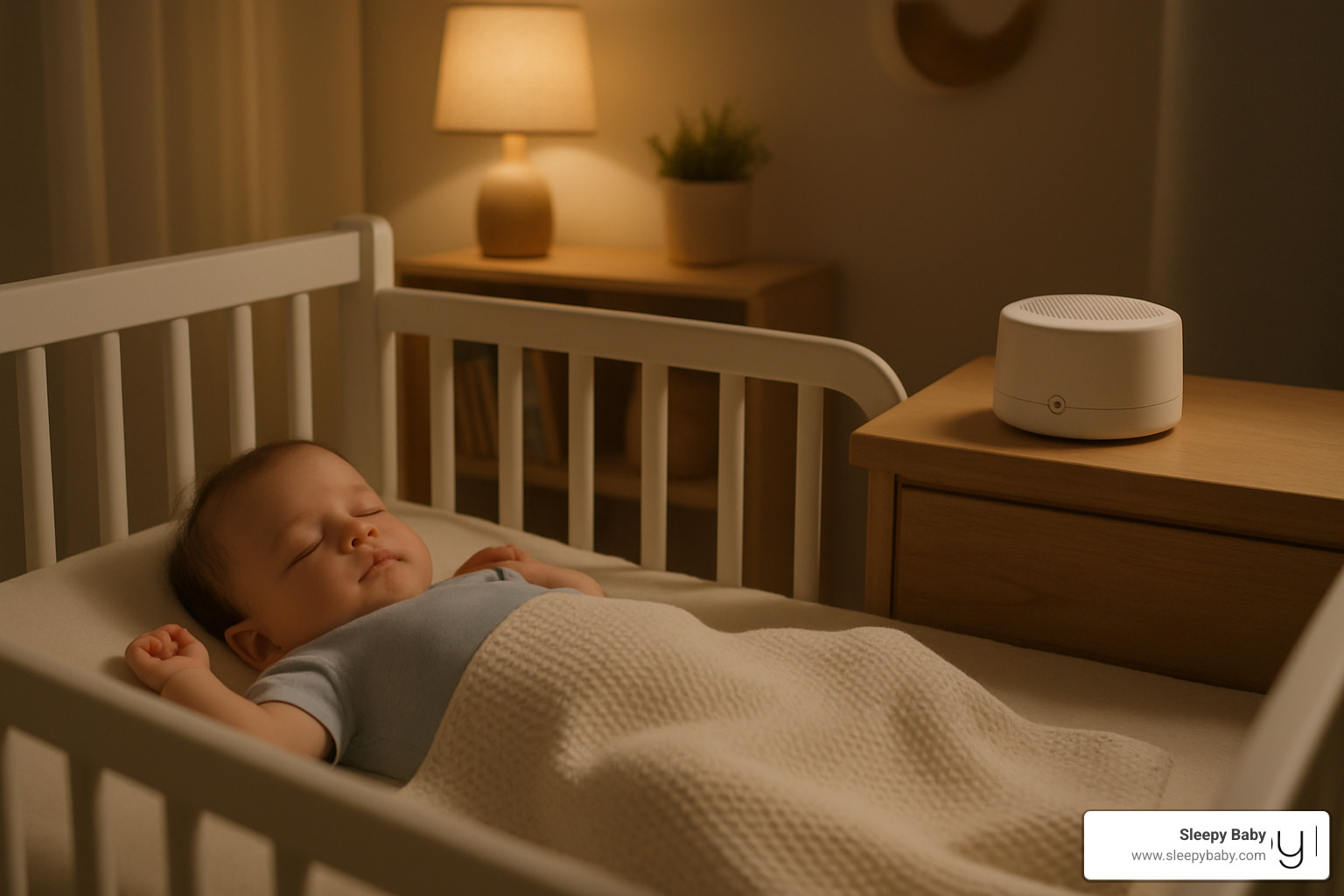
Conclusion
Understanding white noise in the womb completely changes how we approach those challenging early months of parenthood. Your baby spent nine months in what was essentially nature's first sound machine - a surprisingly loud world filled with your heartbeat, blood flow, and digestive sounds reaching up to 91 decibels.
Then suddenly, they're born into what feels like deafening silence.
This dramatic shift explains why so many newborns struggle with sleep and why that landmark 1990 study found 80% of babies fell asleep within five minutes when exposed to familiar white noise. We're not just masking household sounds - we're recreating the acoustic comfort zone your baby knew as home.
But here's what matters most: safety always comes first. Keep volume at 50 decibels maximum, place devices well away from the crib, and remember that white noise is a tool to support healthy sleep habits, not create permanent dependency.
Every family's sleep journey looks different, and that's perfectly normal. Some babies respond immediately to white noise, while others need a combination of approaches.
At Sleepy Baby, we've seen how combining white noise in the womb principles with gentle rhythmic patting can transform those exhausting nights into peaceful rest for the whole family. Our portable sleep aids don't just play sounds - they recreate both the acoustic and tactile comfort your baby experienced before birth, offering comprehensive soothing that helps babies develop independent sleep skills.
Whether you choose a simple white noise machine, find that your hair dryer works wonders, or invest in more sophisticated sleep solutions, you're giving your baby the gift of familiar comfort during one of life's biggest transitions. That constant whoosh and rhythm they heard for nine months was their first lullaby - and now you can help that beautiful tradition continue.
For more guidance on creating the perfect sleep environment for your little one, explore our comprehensive guide: Dreamland Awaits: Best Sleep Aids for Your Newborn.
Sweet dreams to you and your baby - may you both find the rest you deserve.


